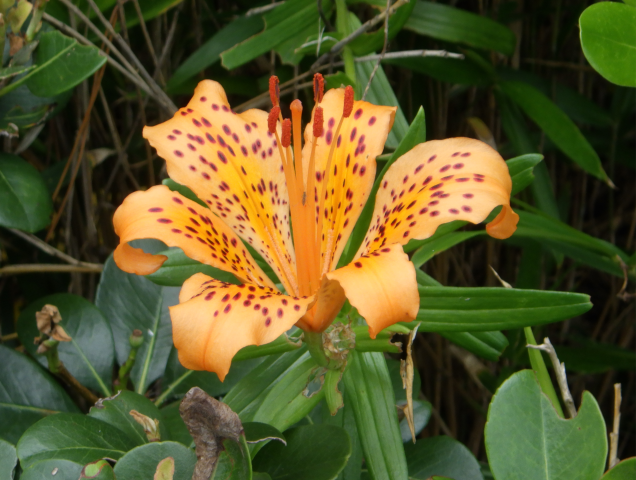Research News
May 1, 2024
- Science
New Japanese lily species identified, 1st addition to sukashiyuri group in 110 years
Classification of these plants bloom to double the number of taxonomic groups through morphological study, DNA analysis
The new species of Japanese lily Lilium pacificum
Among the characteristics differentiating this lily from other sukashiyuri are its leaves, which curve almost like a claw at the tips.
Credit: Osaka Metropolitan University

A new species of the Japanese lily known as sukashiyuri has been identified for the first time since 1914 by a research team led by Dr. Seita Watanabe, a specially appointed assistant professor at the Botanical Gardens and the Graduate School of Science at Osaka Metropolitan University.
Dr. Watanabe questioned the classification used up to now for sukashiyuri group, which usually has orange flowers. These lilies have high ornamental value, having been exported from Japan for more than two centuries. There have been only four taxonomic groups, but Dr. Watanabe and his team sought evidence to prove that there were more.
Traveling across Japan to observe the lilies, record images, gather specimens, and obtain DNA from plant materials, the research team members conducted a detailed analysis of the form and structure of the plants and their DNA. The results of their extensive work revises the conventional classification into eight taxons, including what they have named Lilium pacificum, the first new species of Japanese lily in 110 years.
Lilium pacificum grows on coastal areas facing the Pacific Ocean on Honshu from Ibaraki Prefecture south to Shizuoka Prefecture and the Izu Islands.
“It has an interesting characteristic: the tips of its leaves are curved into a claw-like shape,” Dr. Watanabe enthused. “Based on the new understanding of these eight taxonomic groups, we found that seven are endemic to Japan, each adapted to its environment, whether coastal or mountainous, and evolving unique traits.”
Dr. Watanabe added: “Our research shows that these plants have differentiated through complex processes, and we hope that our work will provide clues for speciation studies. In the past, individual differences may have been overlooked because of the apparent simplicity of the plants. Through this research, I was reminded of the importance of morphological observation.”
The findings were published in Taxon.
Funding
This study was supported in part by Japan Society for the Promotion of Science KAKENHI (Grants-in-Aid for Scientific Research) grant numbers JP25440207 and JP16H05763.
Paper information
Journal: Taxon
Title: Biosystematic studies on Lilium (Liliaceae) II. Evolutionary history and taxon recognition in the L. maculatum–L. pensylvanicum complex in Japan
DOI: 10.1002/tax.13141
Authors: Seita T. Watanabe, Kazuhiko Hayashi, Katsuro Arakawa, Shizuka Fuse, Koji Takayama, Hidetoshi Nagamasu, Minoru N. Tamura
Published: 16 February 2024
URL: https://doi.org/10.1002/tax.13141
Contact
Seita Watanabe
OMU Botanical Gardens
Graduate School of Science
Email: seiwatanabe[at]omu.ac.jp
*Please change [at] to @.
SDGs

